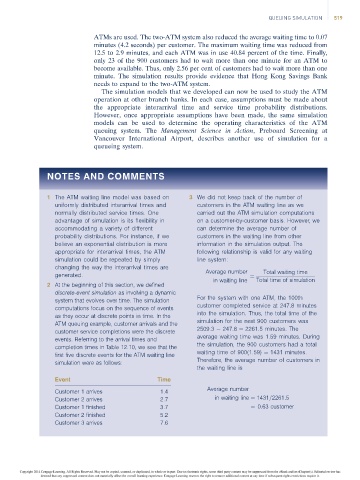Page 539 -
P. 539
QUEUING SIMULATION 519
ATMs are used. The two-ATM system also reduced the average waiting time to 0.07
minutes (4.2 seconds) per customer. The maximum waiting time was reduced from
12.5 to 2.9 minutes, and each ATM was in use 40.84 percent of the time. Finally,
only 23 of the 900 customers had to wait more than one minute for an ATM to
become available. Thus, only 2.56 per cent of customers had to wait more than one
minute. The simulation results provide evidence that Hong Kong Savings Bank
needs to expand to the two-ATM system.
The simulation models that we developed can now be used to study the ATM
operation at other branch banks. In each case, assumptions must be made about
the appropriate interarrival time and service time probability distributions.
However, once appropriate assumptions have been made, the same simulation
models can be used to determine the operating characteristics of the ATM
queuing system. The Management Science in Action, Preboard Screening at
Vancouver International Airport, describes another use of simulation for a
queueing system.
NOTES AND COMMENTS
1 The ATM waiting line model was based on 3 We did not keep track of the number of
uniformly distributed interarrival times and customers in the ATM waiting line as we
normally distributed service times. One carried out the ATM simulation computations
advantage of simulation is its flexibility in on a customer-by-customer basis. However, we
accommodating a variety of different can determine the average number of
probability distributions. For instance, if we customers in the waiting line from other
believe an exponential distribution is more information in the simulation output. The
appropriate for interarrival times, the ATM following relationship is valid for any waiting
simulation could be repeated by simply line system:
changing the way the interarrival times are
Average number Total waiting time
generated. ¼
in waiting line Total time of simulation
2 At the beginning of this section, we defined
discrete-event simulation as involving a dynamic
For the system with one ATM, the 100th
system that evolves over time. The simulation
customer completed service at 247.8 minutes
computations focus on the sequence of events
into the simulation. Thus, the total time of the
as they occur at discrete points in time. In the
simulation for the next 900 customers was
ATM queuing example, customer arrivals and the
2509.3 247.8 ¼ 2261.5 minutes. The
customer service completions were the discrete
average waiting time was 1.59 minutes. During
events. Referring to the arrival times and
the simulation, the 900 customers had a total
completion times in Table 12.10, we see that the
waiting time of 900(1.59) ¼ 1431 minutes.
first five discrete events for the ATM waiting line
Therefore, the average number of customers in
simulation were as follows:
the waiting line is
Event Time
Average number
Customer 1 arrives 1.4
Customer 2 arrives 2.7 in waiting line ¼ 1431=2261:5
Customer 1 finished 3.7 ¼ 0:63 customer
Customer 2 finished 5.2
Customer 3 arrives 7.6
Copyright 2014 Cengage Learning. All Rights Reserved. May not be copied, scanned, or duplicated, in whole or in part. Due to electronic rights, some third party content may be suppressed from the eBook and/or eChapter(s). Editorial review has
deemed that any suppressed content does not materially affect the overall learning experience. Cengage Learning reserves the right to remove additional content at any time if subsequent rights restrictions require it.

